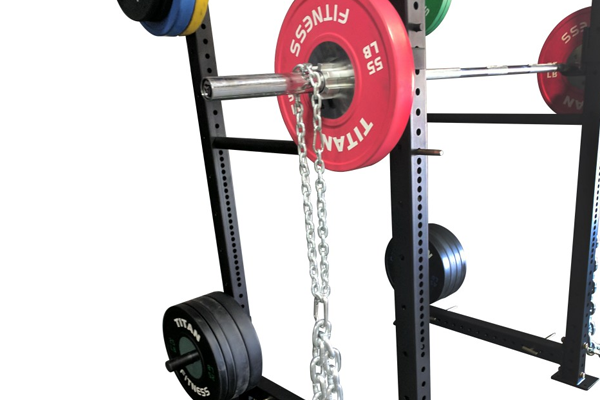Accommodating Resistance | Chains

Accommodating Resistance
A significant advancements in strength training is the principle of “accommodating resistance” and it’s use of chains as a tool to smash through plateaus and increase intra muscular tension to new levels that were previously impossible without the use of fancy, and very hard to find, machines. Properly I would expect a six week macro-cycle using chains to improve an advanced trainee’s bench press by anything from 10-20%. And that’s enough to turn a semi respectable 250lb bench into 290lb plus effort.
Accommodating Resistance and the Strength Curve
By attaching a set of chains to a barbell we derive the benefit most often described as “accommodating resistance”. Accommodating resistance can be though of as using a special means to accommodate resistance throughout the entire range of motion rather than a specific point. Because of leverage issues and the velocity of movement, the force of any movement is less at certain joint angles. For example, in the barbell squat you may be able to quarter squat 400 pounds while you can only full squat 250.
The point of using chains is to help you overcome an exercise’s sticking point & improve the natural strength curve. Simply put, chains should be set up so that when you are at the weakest point of the lift, most of the heavy chain is lying on the ground. This makes the weight on the bar lighter when leverage is at it’s poorest. Using the bench press as an example, most people are weakest a couple of inches or so off their chest and this bottom part of the movement is where the chains are still only minimally brought into play. The higher the bar ascends, the more chains are off the floor and the heavier the weight becomes. Thus flattening the strength curve and providing what we call accommodating resistance.
Why is this a good thing?
Given that chains make for a flatter strength curve, and therefore a harder movement at the top of the curve, you are therefore forced to explode quicker and push harder, for longer, than before.
Chains also decrease deceleration at the top of the strength curve so the movements are more like the movements in sports and allow you to work at close to maximum power output throughout the entire range of motion.
The results:
1. Greater mean and peak forces were generated throughout the movement
2. The stronger eccentric loading and brief transition period provided neuromuscular stimulation similar to that found in Plyometric training
3. The force generated during the later stages increased, in strong contrast to that of a normal movement in which force production tends to decrease significantly.”
How To Incorporate Chains Into Your Workout
There are a few rules of thumb that must be adhered to when seeking to incorporate the advantages of chains into your workouts:
1) Have a training age. Until you have reached a certain level of strength and development it is always better to save the most advanced techniques until you have hit a sticking point and need a new boost.
2) The use of chains can be extremely demanding on the nervous system and is best cycled in as a change of pace.
3) Tempo is paramount and under control.
4) The use of chains is very effective in increasing strength and used properly can be used in an aerobic cycle.
Get the shirt at gottado.threadless.com
The take-away.
A training plan that includes chains can give you yet another way to get to your fitness goals. Breakiing up your training will lead to faster gains and quicker results. NO Passion ... NO Success.
… Just do something. The results will Come!!!!
Call Steve, In-Training Sports | 561-281-8330
In Training Sports
www.intrainingsports.com
Personal Trainer,
servicing West Palm Beach, Palm Beach, Wellington and Jupiter Florida
3131 Village Blvd, #305
West Palm Beach, FL 33409
